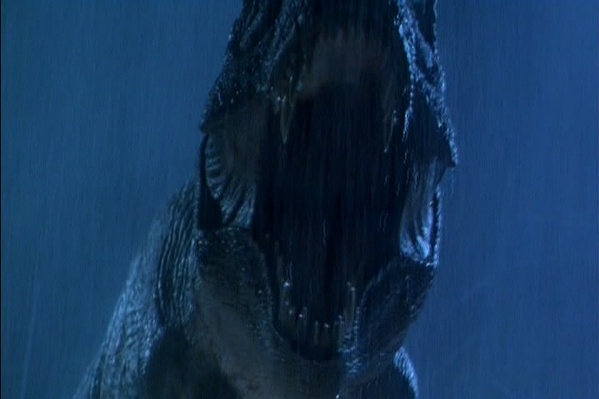The excavation uncovered one set of remains, then another, then another.
挖掘工作发现了一具骨骸之后又一具之后再一具。
Soon, they had thousands of bones from multiple species.
很快就有了来自多个物种的数千块骨头。
The Cleveland Lloyd quarry is absolutely one of the most remarkable fossil sites in the world.
克利夫兰劳埃德石场绝对是世界上最了不起的化石地点之一。
Over 15,000 individual bones have come out of this quarry.
这片石场出土了一万五千多块骨头。

Paleontologists think that's not even half the amount of bones that are still buried in the ground.
古生物学家们认为这还不到地下仍然埋藏着的骨化石的一半。
It's an amazing site, but one of the first things have to ask is, why are so many bones from so many different kinds of dinosaurs assembled in that one location?
这是个绝妙的地方,不过要问的第一个问题是为什么这么多种不同种类恐龙的这么多骨头会汇集在一个地点呢?
Thousands of bones lay scattered across an area no more than a mile across.
整片地方散布着数千块骨头覆盖半径超过一公里半。
Then, another revelation.
然后是另一个启示。
Of the bones found at the site, almost every herbivore bone recovered showed signs of being crushed, broken and bitten.
在石场发现的骨头里,几乎每块植食动物的骨头上都有被压碎、断裂和被咬过的痕迹。
Deep gashes in some bones.
有些骨头上有深深的沟痕。
Others had been somehow pulverized.
其它的都有一定程度的碎裂。
They needed to explain why all of these dinosaurs had perished at this one site.
需要解释的是为什么这些恐龙都死在这个地方。
The paleontologists first employed a scientific approach called taphonomy.
古生物学家首选使用的科学方法叫做埋葬学。
Taphonomy is basically looking at what happened to a fossil from the time of death of an animal until it actually is buried and fossilized.
埋葬学基本上是研究古生物从死亡到被埋葬成为化石而被保存下来的学科。
And taphonomy is basically a technique for understanding what lead to the death and burial of the animal or the plant itself.
埋葬学基本上就是一种用来了解动物或植物死亡和被埋原因的技术。
So we can get a tremendous amount of information just by being careful in how we excavate our sites,
所以我们只要在进行挖掘的时候细心就能获得非常多的信息,
because that gives us clues about what happens leading up to the death of that animal.
这会给我们带来相关线索发现导致该动物死亡的事件。
Taphonomy evidence revealed that the site was once a freshwater lakebed.
埋葬学证据揭示了该地点原来是淡水湖床。
During times of extreme drought, the water levels in a lake can shrink pretty rapidly.
在极度干旱期间,湖中水位能迅速下降。
As they shrink, what happens is the upper layer of mud sort of becomes dry, when underneath, it remains pretty wet and sticky.
随着水位下降,湖泥的表层就会变干而下面仍然又湿又粘。
So as animals walk out across this to get to the water and get a drink, they get stuck.
所以当动物从上面走过去到水边喝水时就会被困住。
Their weight causes them to crack through the upper crust and that's when they get stuck and they're not gonna get out.
它们的重量会压碎表层硬壳而一旦被困住,它们就无法脱身。
It was the first vital clue.
这是第一个重要线索。
This prehistoric death trap was once a lakebed.
这个史前死亡陷阱曾是一片湖床。
Many species would have come to drink here.
很多种动物会来此饮水。
Then, another breakthrough.
然后又有了突破性进展。
Scientists identified one of the dinosaurs.
科学家们鉴别出来其中一种恐龙。
It was one of the most distinctive of the Jurassic period - Stegosaurus.
侏罗纪时期最标志性的恐龙之一剑龙。



